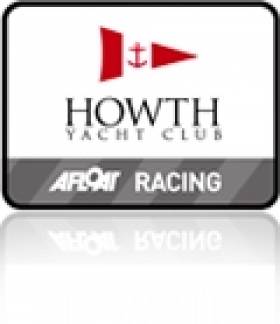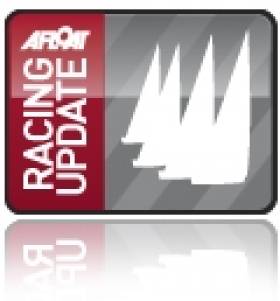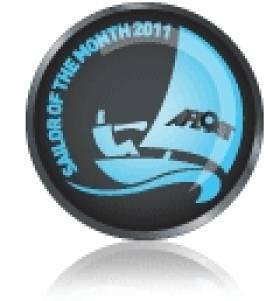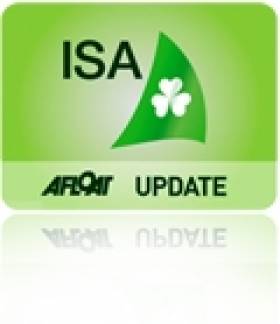Displaying items by tag: j80
For Sale – A Fleet of Eight J/80 Keelboats
The Irish Sailing Association (ISA) has put its fleet of eight J/80 keelboats on the market.
The national governing body is seeking 'Expressions of Interest' (EOI) from parties by noon 3rd June 2016 regarding the purchase of eight J80 keelboats. A form (downloadable below) sets out how to register interest.
The fleet was founded in 2007 as an initiative of the Irish Sailing Association (ISA) which through providing a fleet of small keelboats aimed to increase participation in the sport of sailing and facilitate Clubs to host major events. Seven Founding Clubs became involved as did private Partners with part funding from the Dept of Arts, Sports and Tourism at the time.
The fleet of 8 J80 keelboats were used to 'introduce new people to sailing, underpin major events including World Championships and create a platform for Clubs to own their own boats to attract new and younger members'.
The fleet is now in its 9th year and the ISA say the time is right for SailFleet to examine renewal and other initiatives for the benefit of Irish Sailing. The association's Jack Roy, who is in charge of the sale, says 'any money realised will be reinvested in Irish sailing'.
J80 Sails Stolen From Royal Thames Yacht Club
10 symmetric North spinnakers, 3 mainsails and 5 vertical battened Jibs all in brand new condition along with 8 carbon assymetric spinnaker poles and 24 RTYC branded Spinlock Wing PFDs in new condition all contained in an Ifor Williams trailer branded with "Royal Thames Yacht Club and Royal Yacht Squadron J/80 Fleet support trailer"
If offered any of these unusual items (they are no use other than to "in class" J/80s) there is a reward offered for successful recovery of any of the items you are asked to contact the RTYC Chief sailing officer Richard Ambler [email protected]
This weekend’s two-day All-Ireland Sailing Championship at the National Yacht Club in Dun Laoghaire, racing boats of the ISA J/80 SailFleet flotilla, is an easy target for facile criticism. Perhaps because it tries to do so much in the space of only two days racing, with just one type of boat and an entry of 15 class championship-winning helms, inevitably this means it will be seen by some as falling short of its high aspiration of providing a true Champion of Champions.
Yet it seldom fails to produce an absolute cracker of a final. Last year, current defending champion Anthony O’Leary of Cork, racing the J/80s in Howth and representing both ICRA Class 0 and the 1720 Sportsboats, snatched a last gasp win from 2013 title-holder Ben Duncan of the SB20s, thereby rounding out an utterly exceptional personal season for O’Leary which saw him go on to be very deservedly declared the Afloat.ie “Sailor of the Year” 2014.
So this year, with a host of younger challengers drawn from a remarkable variety of sailing backgrounds, the ever-youthful Anthony O’Leary might well see himself in the position of the Senior Stag defending his territory against half a dozen young bucks who will seem to attack him from several directions. And with winds forecast to increase in strength as the weekend progresses, differing talents and varying levels of athletic ability will hope to experience their preferred conditions at some stage, thereby getting that extra bit of confidence to bring success within their reach. It’s a fascinating scenario, and W M Nixon tries to set this unique event in perspective.
When the founding fathers of modern dinghy racing in Ireland set up the Irish Dinghy Racing Association (now the ISA) in 1946, they would have been reasonably confident that the immediate success of their new pillar event, the Helmsman’s Championship of Ireland, gave hope that a contest of this stature would still be healthily in being, and still run on a keenly-followed annual basis, nearly seventy years later.
They might even have been able to envisage that it would have been re-named the All-Ireland Championship, even if their original title of Helmsman’s Championship had a totally unique and clearly recognisable quality, for they’d have accepted its fairly harmless gender bias was going to create increasing friction with the Politically Correct brigade.
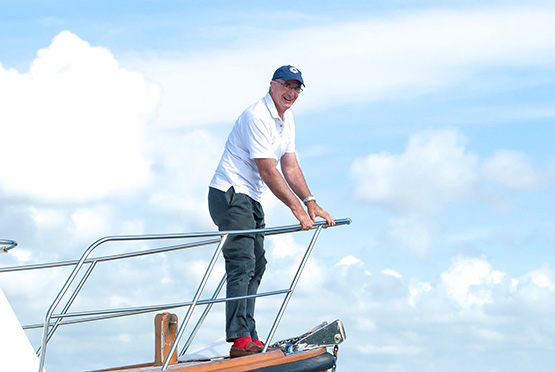 The Stag at Bay? Anthony O’leary sniffs the breeze last weekend, in charge of racing in the CH Marine Autumn league. This weekend he defends his All-Ireland title in Dun Laoghaire. Photo: Robert Bateman
The Stag at Bay? Anthony O’leary sniffs the breeze last weekend, in charge of racing in the CH Marine Autumn league. This weekend he defends his All-Ireland title in Dun Laoghaire. Photo: Robert Bateman
 Sailing should be fun, and run with courtesy – invitation to enjoyable racing, as displayed last weekend in Cork on Anthony O’Leary’s Committee Boat. Photo: Robert Bateman
Sailing should be fun, and run with courtesy – invitation to enjoyable racing, as displayed last weekend in Cork on Anthony O’Leary’s Committee Boat. Photo: Robert Bateman
But what those pioneering performance dinghy racers in 1946 can scarcely have imagined was that, 69 years later, no less than a quarter of the coveted places in the All-Ireland Championship lineup of 16 sailing stars would be going to helms who have qualified through winning their classes within the Annual National Championship of a thirteen-year-old all-Ireland body known as the Irish Cruiser-Racing Association.
And if you then further informed those great men and women of 1946 that those titles were all won in an absolute humdinger of a four-day big-fleet national championship staged in the thriving sailing centre and Irish gourmet capital of Kinsale, they’d have doubted your sanity. For in the late 1940s, Kinsale had slipped almost totally under the national sailing radar, while the town generally was showing such signs of terminal decline that there was little enough in the way of resources to put any food on any table, let alone think in terms of destination restaurants.
So in tracing the history of this uniquely Irish championship (for it long pre-dates the Endeavour Trophy in England), we have a convenient structure to hold together a manageable narrative of the story of Irish sailboat racing since the end of World War II. Add in the listings of the Irish Cruising Club trophies since the first one was instituted in 1931, then cross-reference this info with such records as the winners of the Round Ireland race and the Dun Laoghaire to Dingle Race, beef it all up with the winners of the national championship of the largest dinghy and inshore keelboat classes, and a comprehensible narrative of our national sailing history emerges.
 The veteran X332 Equinox (Ross McDonald) continues to be a force in Irish cruiser-racing, and by winning her class in the ICRA Nationals in Kinsale at the end of June, Equinox is represented in the All Irelands this weekend by helmsman Simon Rattigan. Photo: W M Nixon
The veteran X332 Equinox (Ross McDonald) continues to be a force in Irish cruiser-racing, and by winning her class in the ICRA Nationals in Kinsale at the end of June, Equinox is represented in the All Irelands this weekend by helmsman Simon Rattigan. Photo: W M Nixon
It’s far from perfect, but it’s a defining picture nevertheless, even if it lacks the inside story of the clubs. Be that as it may, in looking at it properly, we get a greater realization that the All-Ireland Helmsman’s Championship (or whatever you’re having yourself) is something very important, something to be cherished and nurtured from year to year.
Of course I’m not suggesting that we should all be out in Dublin Bay today and tomorrow on spectator boats, avidly watching every twist and turn as eight identical boats race their hearts out with a variety of helms calling the shots. Unless you’re in a particular helmsperson’s fan club, it’s really rather boring to watch from end to end, or at least until the conclusion of each stage and then the final races.
This is very much a sport for the “edited highlights”. The reality is that no matter how they try to jazz it up, sailing is primarily of interest only to those actively taking part, or directly engaged in staging each event. When great efforts are made to make it exciting for casual spectators, it costs several mints and results in rich people and highly-resourced teams engaged in costly and often unseemly battles to which genuine sporting sailors cannot really relate at all.
But with its exclusion of Olympic and some High Performance squad members, the All-Ireland in its current form is the quintessence of Irish local and national sailing. It’s almost compulsive for its participants, it provides an extra interest for their supportive clubmates, and in its pleasantly low key way it’s a genuine expression of real Irish sailing, the sailing of L’Irlande profonde.
So of course we agree that it might be more interesting for the bright young people if it was raced in something more trendy like the RS400s if they could find sufficient owners to risk their boats in this particular bear pit. And yes indeed, the ISA Discussion Paper and Helmsmans Guidelines of 2012 did indeed hope that within three years, the All Ireland would be staged in dinghies.
But we have to live in the real world. Sailing really is a sport for life, and some of our best sailors are truly seniors who would be disadvantaged if it was raced in a boat making too many demands on sheer athleticism, for which the unattainable Olympic Finn would be the only true answer.
But in any case, if you watch J/80s racing in a breeze, there’s no doubting the advantage a bit of athletic ability confers, yet the cunning seniors can overcome their lack of suppleness and agility with sheer sailing genius.
 While they may be keelboats, in a breeze the J/80s will sail better with some athleticism, as displayed here by Ben Duncan (second left) as he sweeps toward the finish and victory in the 2013 All Irelands at Howth. Photo: Aidan Tarbett
While they may be keelboats, in a breeze the J/80s will sail better with some athleticism, as displayed here by Ben Duncan (second left) as he sweeps toward the finish and victory in the 2013 All Irelands at Howth. Photo: Aidan Tarbett
 Yet a spot of sailing genius can offset the adverse effects of advancing years – Anthony O’Leary (right) with Dylan Gannon (left) and Dan O’Grady after snatching victory at the last minute in 2014. Photo: Jonathan Wormald.
Yet a spot of sailing genius can offset the adverse effects of advancing years – Anthony O’Leary (right) with Dylan Gannon (left) and Dan O’Grady after snatching victory at the last minute in 2014. Photo: Jonathan Wormald.
But another reality we have to accept is that Ireland is only just crawling out of the Great Recession. And in that recession, it was the enduring competitiveness of ageing cruiser-racers and the sporting attitude of their owners which kept the national sailing show on the road. Your dyed-in-the-wool dinghy sailor may sneer at the constrictions of seaborn truck-racing. But young sailors who were realists very quickly grasped that if they wanted to get regular sailing with good competition as the Irish economy went into free fall, then they had to hone their skills in making boats with lids, crewed by tough old birds most emphatically not in the first flush of youth, sail very well indeed.
Thus in providing a way for impecunious young people to keep sailing through the recession, ICRA performs a great service for Irish sailing. And the productive interaction between young and old in the ICRA fleets, further enlivened by their different sailing backgrounds, has resulted in a vibrant new type of sailing community where it is regarded as healthily normal to be able to move between dinghies and keelboats and back again.
The final lineup of entries is a remarkable overview of the current Irish racing scene, and if you wonder why the winner of the GP14 British Opens 2015, Shane McCarthy of Greystones, is not representing the GP 14s, the word is he’s unavailable, so his place is taken by Niall Henry of Sligo.
2014 Champion Anthony O'Leary, RCYC
RS400 Alex Barry, Monkstown Bay SC
GP14 Niall Henry ,Sligo Yacht Club
Shannon OD Frank Browne, Lough Ree YC
Flying Fifteen David Gorman, National YC
Squib Fergus O'Kelly, Howth YC
ICRA 1 Roy Darrer, Waterford Sailing Club
Mermaid Patrick, Dillon Rush SC
Laser Std Ronan Cull, Howth YC
SB20 Michael O'Connor, Royal St.George YC
IDRA14 Alan Henry, Sutton DC
RS200 Frank O'Rourke, Greystones SC
ICRA 2 Simon Rattigan, Howth YC
ICRA 4 Cillian Dickson, Howth YC
Ruffian Chris Helme, Royal St.George YC
As a three-person boat with a semi-sportsboat performance, the J/80 is a reasonable compromise between dinghies and keelboats, and the class has the reputation of being fun to sail, which is exactly what’s needed here.
The Sailing Olympics and the ISAF Worlds may be terribly important events for sailing in the international context, but nobody would claim they’re fun events. Equally, though, you wouldn’t dream of suggesting the All-Ireland is no more than a fun event. But it strikes that neat balance between tough sport and sailing enjoyment to make it quite a good expression of the true Irish amateur sailing scene.
Inevitably from time to time it produces a champion whose sailing abilities are so exceptional that it would amount to a betrayal of their personal potential for them not to go professional in some way or other. But fortunately sailing is such a diverse world that two of the outstanding winners of the Helmsman’s Championships of Ireland have managed to make their fulfilled careers as top level professional sailors without losing that magic sense of fun and enjoyment, even though in both cases it has involved leaving Ireland.
Their wins were gained in the classic early Irish Yachting Association scenario of a one design class which functioned on a local basis being able to provide enough reasonably-matched boats to be used for the Helmsman’s, and the three I best remember were when Gordon Maguire won in 1982 on Lough Derg racing Shannon One Designs, then in the 1970s Harold Cudmore won on Lough Neagh racing Flying Fifteens, and in 1970 itself, a very young Robert Dix was winner racing National 18s at Crosshaven.
Gordon Maguire was the classic case of a talented sailor having to get out of Ireland to fulfill himself. His win in 1982 in breezy conditions at Dromineer in Shannon One Designs, with Dave Cummins of Sutton on the mainsheet, was sport at its best, though I doubt that some of the old SODs were ever the better again after the hard driving they received.
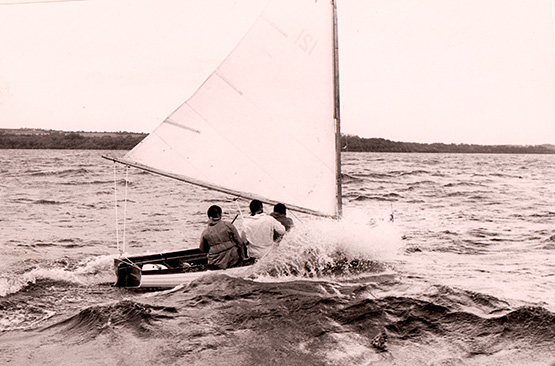 Driving force. Gordon Maguire going indecently fast for a Shannon One Design, on his way to winning the Helmsmans Championship of Ireland at Dromineer in 1982. Photo: W M Nixon
Driving force. Gordon Maguire going indecently fast for a Shannon One Design, on his way to winning the Helmsmans Championship of Ireland at Dromineer in 1982. Photo: W M Nixon
Then Gordon spread his wings, and won the Irish Windsurfer Nationals in 1984 - a great year for the Maguires, as his father Neville (himself a winner of the Helmsmans Championship five times) won the ISORA Championship with his Club Shamrock Demelza the same weekend.
But Gordon needed a larger canvas to demonstrate his talents, and in 1991 he was a member of the Irish Southern Cross team in Australia, a series which culminated in the Sydney-Hobart Race. The boat which Maguire was sailing was knocked out in a collision with another boat (it was the other boat’s fault), but Maguire found a new berth as lead helm on the boat Harold Cudmore was skippering for the Hobart Race, and they won that overall.
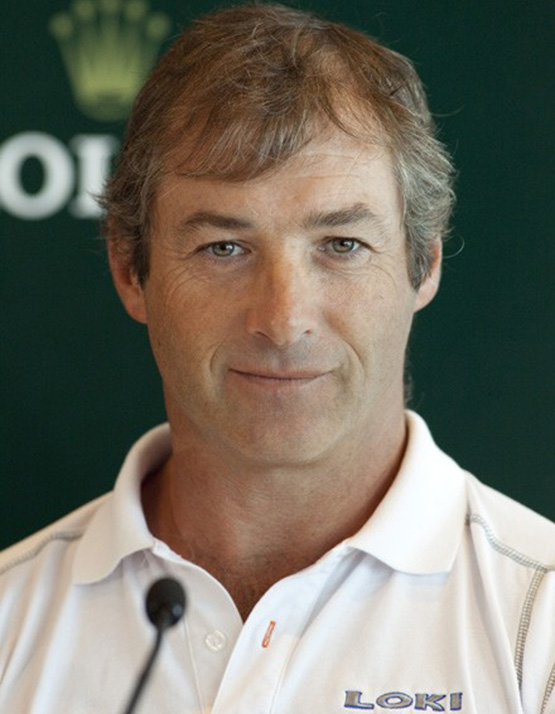 A man fulfilled, Gordon Maguire at the beginning of his hugely successful linkup with Stephen Ainsworth’s RP 63 Loki
A man fulfilled, Gordon Maguire at the beginning of his hugely successful linkup with Stephen Ainsworth’s RP 63 Loki
And Gordon Magure realized that for his talents, Australia was the place to be. More than twenty years later, he was to get his second Hobart Race overall win in command of Stephen Ainsworth’s RP 63 Loki, and here indeed was a man fulfilled, revelling in a chosen career which would have been unimaginable in Ireland.
Harold Cudmore had gone professional as best he could in 1974, but it was often a lonely and frustrating road in Europe. However, his win of the Half Ton Worlds in Trieste in the Ron Holland-designed, Killian Bushe-built Silver Shamrock in 1976 put his name up in lights, and he has been there ever since, renowned for his ability to make any boat perform to her best. It has been said of him when racing the 19 Metre Mariquita in the lightest conditions, that you could feel him getting an extra ounce of speed out of this big and demanding gaff-rigged classic seemingly by sheer silent will power.
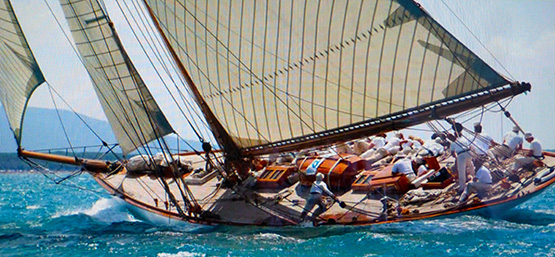
The restored 19 Metre Mariquita is a demanding beast to sail in any conditions…

...but in light airs, Harold Cudmore (standing centre) seems to be able to get her to outsail larger craft by sheer will-power.
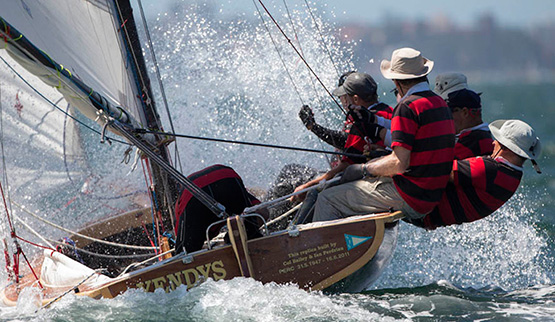 A different scene altogether, but still great sport – Harold Cudmore racing the classic Sydney Harbour 18-footer Yendys
A different scene altogether, but still great sport – Harold Cudmore racing the classic Sydney Harbour 18-footer Yendys
But as for Robert Dix’s fabulous win in 1970, while he went on to represent Ireland in the 1976 Olympics in Canada, he has remained a top amateur sailor who is also resolutely grounded in Irish business life (albeit at a rather stratospheric level). But then it could be argued that nothing could ever be better than winning the Helmsmans Championship of Ireland against the cream of Irish sailng when you’re just 17 years old, and doing it all at the mother club, the Royal Cork, as it celebrated its Quarter Millenium.
It was exactly 44 years ago, the weekend of October 3rd-4th 1970, and for Robert Dix it was a family thing, as his brother-in-law Richard Burrows was Number 2 in the three-man setup. They were on a roll, and how. The manner in which things were going their way was shown in an early race when they were in a tacking duel with Harold Cudmore. Coming to the weather mark, Cudmore crossed them on port, but the Dix team had read it to such perfection that by the time he had tacked, they’d shot through the gap with inches to spare and Cudmore couldn’t catch them thereafter.

Decisive moment in the 1970 Helmsman’s Championship. At the weather mark, Harold Cudmore on port is just able to cross Robert Dix on starboard………Photo W M Nixon
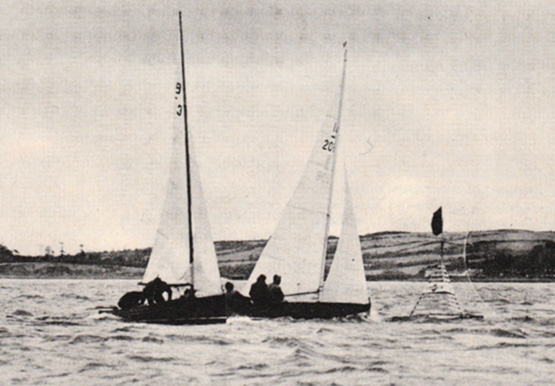 ……but Dix is able to shoot through the gap as Cudmore tacks…..Photo: W M Nixon
……but Dix is able to shoot through the gap as Cudmore tacks…..Photo: W M Nixon
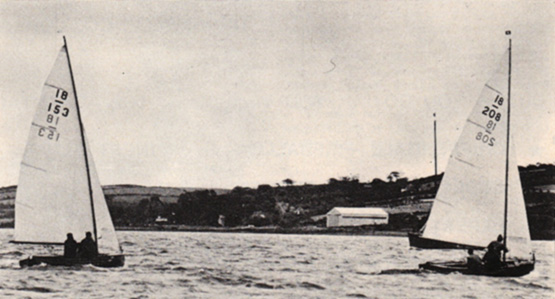 …..and is on his way to a win which will count well towards his overall victory over Cudmore by 0.4 points. Photo: W M Nixon
…..and is on his way to a win which will count well towards his overall victory over Cudmore by 0.4 points. Photo: W M Nixon
Admittedly both Harold Cudmore and the equally-renowned Somers Payne had gear problems, but even allowing for that, the 17-year-old Robert Dix from Malahide was the star of the show, and the final points of Robert Dix 9.5 and Harold Cudmore 9.9 for the 1970 Helmsman’s Championship of Ireland says it all, and it says it as clearly now as it did then.
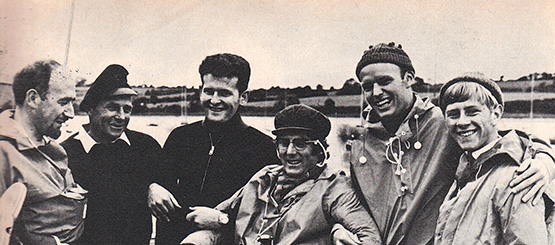
The six finalists in the 1970 Helmsman’s Championship were (left to right) Michael O’Rahilly Dun Laoghaire), Somers Payne (Cork), Harold Cudmore (Cork), Owen Delany (Dun Laoghaire), Maurice Butler (Ballyholme, champion 1969) and Robert Dix (Malahide), at 17 the youngest title holder ever. Photo: W M Nixon
Howth Yacht Club to Stage 2015 ISAF Nations Cup European Final
#matchracing – Ireland's hosting of International Match racing events is set to to continue in 2015 with Howth Yacht Club's annuoncement that it will host the 2015 Nations Cup European Final on 7-10th May 2015. It follows the acclaimed 2014 staging of the ISAF Women's Match Racing World Championship at Royal Cork Yacht Club.
The Howth result follows a recent decent decision by ISAF to award the worldwide regional finals to Buenos Aires (South America), Brisbane (Oceania), San Diego (North America), Tunis (Africa), Bahrain (Asia) and Howth (Europe). The Grand Final will be held in Vladivostok on 14-19th July.
As per the Notice of Race, the ISAF host member national authority may nominate an entry in each of the Open and Women's Division.
The event will be run in the ISA Sailfleet J80s and the full schedule will be announced in due course.
The ISAF Nations Cup was first introduced to the world in 1991. Open and Women's contests are run and it is based on a series of Regional Finals with the top crews meeting at the Grand Final.
Racing at the Regional Finals is preceded by an ISAF Match Racing Clinic, aimed to help develop match racing skills and officiating in that region. The winners of each Regional Final progress to the Grand Final, where they are joined by the defending nation and the host nation.
All relevant information will be published and available on the ISAF website - sailing.org
The aim of the event is to broaden the availability of match racing and provide international match racing competition for national authorities and sailors at a reasonable cost, whilst acting as an incentive for national match racing programmes.
J24 Crew Win Howth Yacht Club's Inaugural Sportsboat Cup
#hyc – Howth Yacht Club's new Sportsboat initiative attracted J24s, J80s and the visiting 1720 European championships for its first outing last weekend.
Well known cJ24 skipper Flor O’Driscoll and the crew of his J24 Hard On Port were the deserving overall Sportsboat Cup winners for 2014 and were awarded the Romaine Cagney Trophy.
Impressively, they did not count a result worse than second for the regatta and won half of the races. The popular winners have been stalwarts of the J24 class in Ireland who also have won several IRC titles in the well campaigned boat. They were only delighted to be taking another piece of silverware out of the Pale to Munster.
The cup was sailed in three days of glorious sunshine and light winds. Suncream and water were some of the most important parts of all crews’ kit every day as temperatures were consistently over 20 degrees. Water was especially important after many of the competitors were burning the midnight oil each evening. Racing was successfully completed on Sunday which incorporated the 1720 Europeans, the J24 Easterns and the Sailfleet J80s. The race officers did exceptionally well to get the full schedule of races completed on both race courses without any delays. The challenging conditions and a big shift meant that the last race of the day on Saturday for the 1720s had to be abandoned to avoid it becoming a lottery. PRO Derek Bothwell’s mantra that “It is better to have no race than a bad race” was a wise one. In any case, there was ample time to make it up on Sunday morning to get all eight races in.
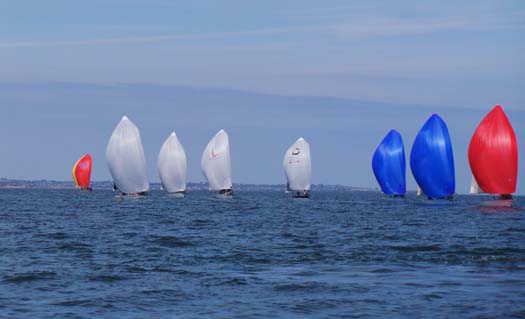
1720s made a welcome return to HYC after over a decade of absence
The 1720 Europeans came down to the wire and was decided in the last race to by the slimmest of margins. After a match race with Denis Murphy’s Aquatack in the last race, Peter O’Leary’s Jacobs Bar emerged victorious by just half a point overall to defend his title from last year. Not far behind the leading pair was a surprise performance from Kenneth Rumball on INSC.ie who rounded out the podium places. Maybe the Dun Laoghaire based team should travel to the events more frequently and the rest of the Dublin based fleet will too. The top performer from outside of Ireland came from Tom Forrestor-Coles and his crew from the south coast of the UK who finished fourth, just two points off the podium.

1720 winners. Pictured Adam Hyland, Cathal Cottrell, Peter O’Leary, Jamie Donegan & Youen Jacob
O’Learys title defence was impressive as earlier this year the boat was in a sorry state after being abandoned for years in a field in Baltimore. Left under a tree with the hatch open the boat was covered in leaves, dirt and the hull was full of water. Before they began the resurrection Cathal Cottrell even joked “We thought of entering the boat in the Chelsea flower show instead of the Europeans when we found her, and we nearly did”. After only rigging a new mast on Thursday night and splashing for the first time early Friday morning, they got off to a relatively slow start but definitely got into their rhythm on Saturday and hauled in Aquatack before conclusion on Sunday. Seventeen year old Adam Hyland was a welcome addition to the crew and O’Leary praised the young talent in his acceptance speech.

Eoin O’Fearghail
When the wind dropped on Saturday for the J24s and J80s racing was as rapid as Elephant Polo. The wind direction chopped and changed to the point where PRO Richard Kissane decided to abandon and restart Race 2. Whereas it didn't suit those doing nicely at the time, it was the sensible decision. The restarted race got away smartly in a bit more breeze allowing the fleet to get all scheduled races under their belts and home in time for tea and tiffin....and after-sun!
Sunday's racing was brought forward an hour to test those who were out the night before. A few cups of Blue Nun did nothing to slow up Flor O'Driscoll and his team who put in a stellar Sunday performance.
Lough Swilly's "Bandit" lived up to its name by putting in a sweet port tack start in Race 5. Open-jawed, the rest of the fleet took some time catching!
Overnight leader Stefan Hyde on Hamilton Bear had a wobbly start to the day but finished off the weekend with a well deserved bullet. In the last they weren’t able to push Hard On Port down the fleet enough in the last to snatch the overall title at the death, so it was second overall for them. Howth Yacht Club’s Under 25 Keelboat Team on Eurocarparks Kilcullen rounded out the podium in third place.
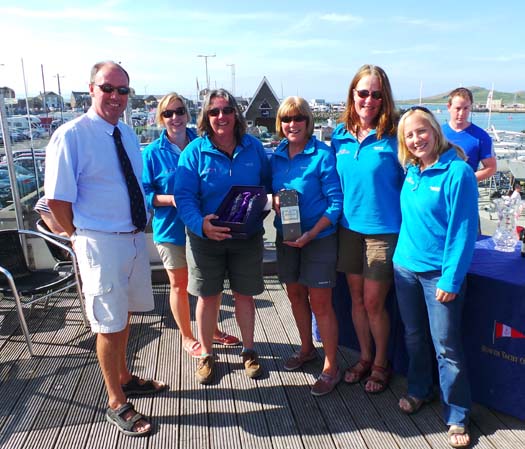
J80 winners. Joan Harris, Gillian Guinness, Elaine Taylor, Sally Watson & Linda Darbey
In the Sailfleet J80 class Gillian Guinness and her ladies team took the title ahead of Mossy Shanahan. In the closely fought class young Ewan McMahon finished a close third. With most of the fleet trading blows Gillian and her crew were very consistent and eked out a lead which meant they had the series wrapped up with a race to spare. There were even sightings of wine and other delights on the sail home each day on board. The bulk of the fleet from second to fifth place were separated by only four points. Exactly what you want and expect from such evenly matched one design racing.
Howth would like to thank all the competitors who made the event as good as it was and Edward Dillon who generously sponsored some prizes. We hope to have everyone back and even more classes involved when we run the event again in 2016.
Full Results here: http://hyc.ie/results
#hyc – With only a week to go anticipation is building for the inaugural HYC Sportsboat Cup at Howth in County Dublin writes Ross McDonald.Three fleets will be battling it out over two racecourses in what is promising to be a spectacular addition to the Irish racing calendar. Racing will begin on Friday the 20th June and run over the weekend on what is the longest day of the year.
Racing will start at midday each day but the fleets will be back on dry land in time to take advantage of the late evening sun. Post sailing music and barbeques are booked for each day along with a sailing supper by HYC's new chef Jason Dunphy (ex Rolys, Conrad and more) on offer for Friday evening. On Saturday evening there will be a midsummer celebration with a dinner dance organised so the club will certainly be a lively spot.
The 1720 Europeans will be held as part of the event which is drawing an international flavour to the racing, with boats travelling from the UK to compete for the title. This is the first time in several years that this event has been held out of the 1720 stronghold of Cork and it is giving the boats from Dublin a new lease of life. Entries are coming in from the host club as well as The Irish, The George and the INSC in Dun Laoghaire. That's not to mention all of the old heads that are popping up on some of the regulars boats to rekindle their love of the 1720 and impart some local knowledge while at it. Boats are starting to arrive this weekend with the aim of familiarising themselves with race area.
The J24 fleet will be hotly contested with several seasoned campaigners and previous regional and national champions battling it out for the title. The fleet have lots of experience racing in Howth and are returning to the battleground of last summer's Worlds and the Europeans from 2011.
The J80s will be populated with lots of notable sailors across a wide range of ages. From young Oppie champions to world match racers and everything in between this racing is promising to be memorable. With all the boats rigged and tuned identically this fleet will come down to nothing but the sailors skills.
As well as awarding fleet prizes a perpetual trophy will be awarded to the overall event winner. The details of how it will be decided will be revealed in the SI's.
There is still time to get an entry in. You can enter online here
Howth Yacht Club Launches Sportsboat Cup for 1720s, SB20s, Quarter Tonners, RS Elites, Dragons & J Boat Classes
#hyc – A Sportsboat Cup for Irish keelboat classes to be held around Midsummers day and tailored especially for 1720s, SB20s, Quarter Tonners, J24s, RS Elites, Dragons, J80s and J70s, is to be staged for the first time at Howth Yacht Club in north Dublin from 20th - 22nd June 2014.
At this multiclass event each of the sportsboat classes will be given their own start, results and prizes.
The event will incorporate the 1720 European championships as part of the event and there is an expectation of visiting UK and continental crews too.
Racing will be one design with the exception of the quarter tonners and mixed class who will race under IRC. Class rules will apply where applicable.
HYC says any other sportsboat type that has an IRC cert will also be accommodated in a mixed sportsboat fleet.
Howth is using the event to champion its sailing facilities both on the water and ashore at the 'bustling fishing village' venue that is also close to Dublin airport.
The largest club in the country has two cranes, a 300–berth marina, sizeable hardstanding, a large club house with bar, terrace and dining facilities not to mention secure changing and showering facilities
HYC is ideally placed to host this Sportsboat Cup. Car parking, craning, berthing and trailer storage are all included in the entry fee and racing will be organised by top National and International Race Officers.
With no racing starting before 12 each day there will be ample time to freshen up in the morning after the great social that is planned for each evening.
Online Entry available by clicking the HYC advert at the top of the Afloat homepage.
Familiar Names Top Lough Derg One Design Keelboat Weekend
#loughderg – This weekend sees the gathering of the biggest of the keelboat one design fleets in Lough Derg for the annual freshwater keelboat regatta. For what is fast becoming a popular feature in the trailer sailor one design classes, Lough Derg Yacht Club is hosting a one design weekend for the Dragons, SB20's, Squibs and J80's.
The classes share the same race area but split between windward/leeward and trapezoid courses with a common start line.
The dragons assembled early on Friday with 2 races sailed and with a further 4 races today out of a 8 race series. Martin Byrne from the Royal St. George YC is clear ahead by the end of racing with a massive 11 point lead over RIYC rival Richard Goodbody. Martin counts 5 race wins in the 6 races sailed.
In the SB20 class 4 races sailed leaves the two front runners on tied points overnight with two first places and a second each for Ben Duncan and Peter Kennedy (RNIYC) each discarding a 10+ point race for 4 points nett, this being a somewhat familiar result between these two top boats. Further back James Gorman and Aidan O'Connell battle it out for 3rd but the Lough has proven a formidable challenge for all crews with the shifting and gusting southerly breeze. Who will emerge as overall leader is very much yet to be decided.
In the J80s Andrew Deacon is having it all his own way with 3 first places but discarding a Joint first (1.5). He is leading overall by 3.5 points to nearest rival Hetty Sanders with a 1.5,2,3.
At the time of writing the squibs overall was dependent on the outcome of a protest so were not available.
A beautiful October sunny day on Lough Derg, some more trying and difficult conditions tomorrow in the heartland of Ireland.
George Kenefick is October's Sailor of the Month
The 23-year-old helmsman won the Quarter Ton Classics Corinthian Division in July with his immaculately-restored boat Tiger, racing against a top lineup in the Solent. That performance saw him recruited to helm the English-owned boat Chimp in the Half Ton Worlds at the same venue in August. Kenefick showed the quality of his abilities by interacting with a crew he'd never sailed with before to become overall winner against an impressive international fleet.

George Kenefick, Mel Collins and John Downey celebrate their win on Lough Derg. Photo: Brendan Fogarty
Back in home waters, next up was the Waterways Ireland ISA National Championship on Lough Derg in the ISA's SailFleet flotilla of J/80s at the beginning of October. For this series Kenefick recruited Crosshaven clubmates John Downey and Mel Collins as crew. The opposition included former champion Mark Mansfield, who had returned to competitive sailing by winning the 1720 Europeans in Baltimore against a fleet including Anthony and Nicholas O'Leary, both former Irish Open Champions.
It went right down to the wire, with Mansfield and O'Leary emerging well ahead on 12–points apiece. On the countback, Kenefick was the new champion. Almost immediately, he was back in the thick of logistics and personnel organization in taking the Cork Institute of Technology sailing team to France for the Student Worlds, CIT representing Ireland as winners of our national series.
With sixteen college teams from all over the world, even in resources-rich French sailing the organizers were stretched in finding an evenly-matched fleet of sixteen Archambault keelboats. There were top class new boats, but some not so new boats, and a trio of boats well past their sell-by date. It was all in the luck of the draw, and the Irish and much-fancied Portuguese found themselves drawing the shortest straw.
In a demanding series, the Portuguese were never at the races with their tired mount, but the Irish simply refused to give up despite a boat which, with its equipment, was falling apart. There was ample opportunity to do this, as the series in the Bay of Biscay off La Trinite included some really rough stuff. In fact, the Irish revelled in the strong breeze, but in the light airs which settled in as the week drew on, it took pure skill.
By the final races last Saturday, they'd got themselves an unassailable third position, but the two British teams – defending champions are allowed an extra place – had miscalculated the points situation. So on the final day, they team raced, one of their boats sailing the Irish crew down the fleet in the best Ben Ainslie style. It was the first time Ireland had finished outside the top six, but they still had the bronze, the Brits took silver, and the French were well ahead to win overall.
More from WM Nixon in the Irish Independent here
O'Leary Not Defending 'All Ireland' Title
The only hat-trick winner of the Irish Sailing Association's (ISA) All Ireland Sailing Championships, Royal Cork's Nicholas O'Leary will not be defending the title when the 2011 event is sailed in two weeks time. Names of the 16 invitees, drawn from dinghy and keelboat classes, were published today. Among those attending is O'Leary's father Anthony representing Cruiser Class Zero and his Crosshaven club mate, the 2011 1720 National Champion Mark Mansfield, a past winner of the event.
Nicholas O'Leary is one of 12 invitees – either national champions or top ranked sailors – who are unavailable to attend. Only 16 of 28 invitees had accepted the invitation by last week's entry deadline.
The Waterways Ireland sponsored event takes place at Lough Derg Yacht Club which was originally scheduled for three days but is now running on the 8th and 9th of October only. The event is raced in J80's.
The 16 invitees are as follows:
|
Name |
Club |
Class |
|
Adrian Allen |
Ballyholme Yacht Club |
Multihull |
|
Roger Bannon |
National Yacht Club |
Mermaid |
|
Noel Butler |
ISA |
Fireball |
|
Alan Claffey |
Royal St. George Yacht Club |
Ruffian |
|
Ben Duncan |
Howth Yacht Club |
Laser SB3 |
|
Brian Goggin |
Kinsale Yacht Club |
ICRA '2' |
|
David Gorman |
National Yacht Club |
Flying Fifteen |
|
Alan Henry |
Sutton Dinghy Club |
IDRA 14 |
|
George Kenefick |
Royal Cork Yacht Club |
ICRA '3' |
|
Mark Mansfield |
Royal Cork Yacht Club |
1720 |
|
John McGuinness |
Moville Sailing Club |
GP14 |
|
Flor O'Driscoll |
Howth Yacht Club |
J24 |
|
Anthony O'Leary |
Royal Cork Yacht Club |
ICRA '0' |
|
Pat O'Neill |
Clontarf Yacht & Boat Club |
E-Boat |
|
Gordon Patterson |
Royal North Yacht Club |
Squib |
|
Ryan Seaton |
Ballyholme Yacht Club |
Olympic 49er |
































